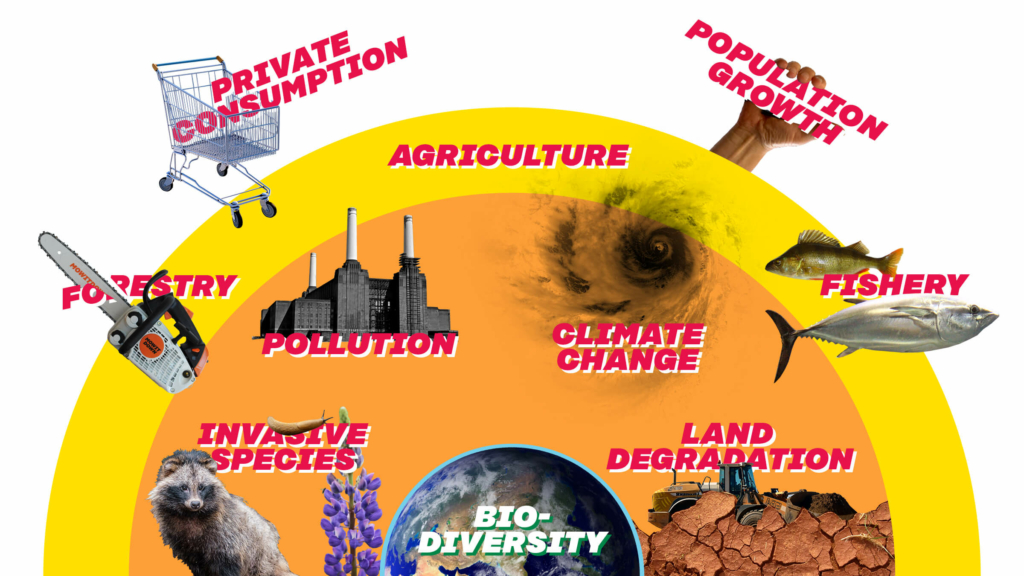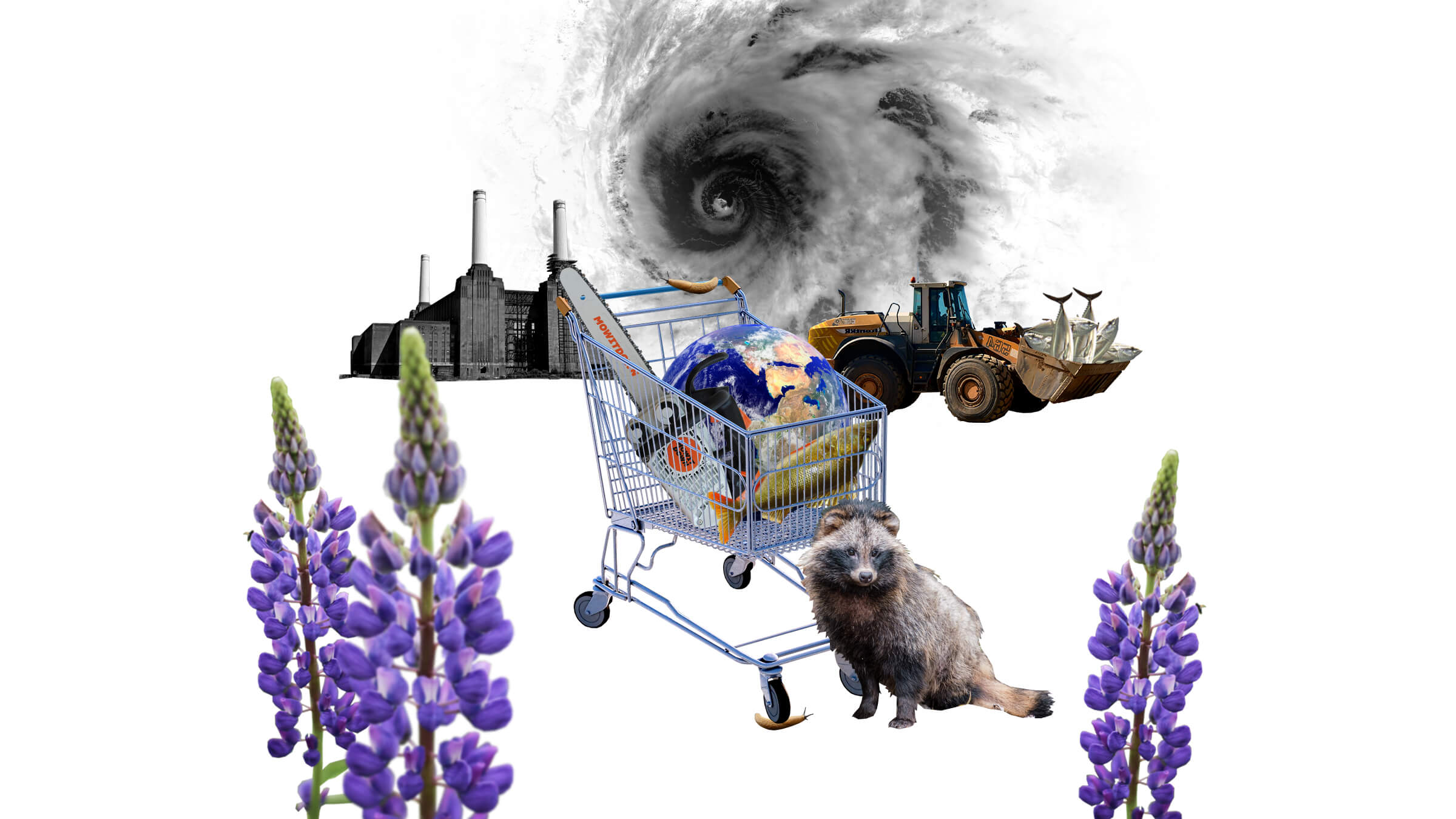The carbon footprinting exercises are valuable to raise awareness of the connection of our lifestyles and climate change. Online tools, such as Sitra’s Lifestyle test, can help us to distinguish major and minor emission sources of our lifestyles. Loss of biodiversity is another pressing environmental problem and consumption patterns have been identified as indirect drivers of it. We set out find if it is possible to develop tools like carbon footprint calculators to estimate and illustrate consumption-based biodiversity footprints.
Yes we can! But we need to consider and work on limitations
Our exploration of research articles, reports, and expert interviews showed that biodiversity footprints of consumption, i.e., biodiversity related pressures from the whole supply chains of the consumed goods and services, is a developing field. Researchers are working on to integrate biodiversity indicators to established modelling frameworks such as environmentally extended input-output analysis and life cycle assessment.
Indicators to measure the intactness of areas (Mean Species Abundance and Potentially Disappeared Fraction of Species) and threatened species are examples of the indicators integrated to the existing modelling frameworks. Researchers have already demonstrated how to study biodiversity implications related to different economic sectors, consumption patterns, and individual products.
The major challenge in the field is related to the phenomenon as such – diversity. Diversity in different environments (terrestrial, marine, freshwater), diversity of drivers (including land use change, direct exploitation of organisms, climate change, pollution, invasive species), and diversity in local conditions and supply chain related specific characteristics. Whereas greenhouse gases contribute to the global warming in the same way despite their geographic origin, changes in biodiversity vary according to spatially specific characteristics.
Food consumption, especially animal-based, typically make large share of the footprint.
Although quantification of biodiversity footprints of consumption seems to be possible, the estimates remain on a rather general level. Thus, findings can for example suggest that out of all domains of consumption, food consumption, especially animal-based, typically make large share of the footprint. Nevertheless, this type finding on a domain and product group suggests an area for more concrete and detailed actions and policies to support shifts in consumption patterns.
Life cycle assessment can be applied to create a more detailed analysis and can be used to estimate and compare individual products. In that way, the biodiversity hotspots of the supply chain can be identified and addressed. This knowledge is important for the work aimed to decrease pressures from production. Nevertheless, estimating the footprint of a whole lifestyle needs to rely on certain generalisations and calculations based on average goods.
Starting to work on the level of detail possible is feasible, but future outcomes of basic research, availability of data, and indicators will capture more detailed perspectives of consumption patterns.
Nevertheless, distinguishing, for instance, the large contribution of food consumption and potential actions to make it smaller is beneficial to draw attention to a relevant consumption domain. Starting from one’s consumption patterns and linking the result to how consumption indirectly drives biodiversity loss is an opportunity to raise awareness of the so-called telecoupled connections. The concept of telecoupling refers to the socioeconomic and environmental interactions over distances, such as how consumption of food and other goods in one country creates local impacts in another part of the world.
How to make sense of biodiversity implications of consumption for citizens?
In addition to experts and academics working on environmental footprints, we also interviewed ten Finnish consumers, in other words non-professionals of environmental issues, about their current perceptions of how their everyday life and consumption is linked to biodiversity. We also asked for feedback on tentative concepts and visualisations to get on overview of drivers of biodiversity loss, and approaches to illustrate biodiversity implications of their personal consumption patterns. In general, consumer attitudes on biodiversity measuring and modelling on the level of individual consumption were mostly positive and the need for communication or modelling tools was recognized in the consumer interviews.
The relationship between climate change and biodiversity loss should be further explained.
The consumer interviews showed varying levels of biodiversity related knowledge among the respondents. The level of knowledge and perception on environmental sustainability in general has implications on the most beneficial means of communications and visualisations. The relationship between climate change and biodiversity loss should be further explained. Biodiversity loss and climate change were often seen as completely overlapping topics, and the actions to inhibit climate change were seen parallel to the ones that halt biodiversity depletion.

Based on the interviews, illustration showing the drivers to put one’s consumption in the picture of biodiversity and visualising the drivers and influencers of biodiversity was well received. It helps to understand the big picture and see a set of underlying drivers besides climate change.
Respondents also reflected how different levels of simplification in communicating the key consumption domains and actions would be beneficial. Those with higher levels of previous knowledge and concern on the biodiversity depletion were not set back with details and even highlighting differences in carbon and biodiversity footprints. On the other hand, those who already see the public discussion are left confused and find the media presenting mixed information regarding biodiversity and environmental issues in general, and it would benefit from more simple communication.
Consumption patterns matter for biodiversity
Ongoing research and development offer interesting possibilities to develop personalised and tailored means to communicate the connections of consumption patterns and biodiversity. That means estimating biodiversity footprints, at least on a simplified level would be possible.
Biodiversity is not only about conservation of areas, but also affected by our consumption patterns.
The value of developing the above-mentioned applications can help in raising awareness on connections of consumption and biodiversity is to show how everything we consume matters, near or far. This approach enhance communication on how biodiversity is not only about conservation of areas, but also affected by our consumption patterns.
Our exploration of written sources and discussions with experts and consumers focused on the footprint perspective. We also briefly touched upon handprint type of positive actions in one’s proximate everyday environment. These could be related to actions such as replacing lawns with meadows and other changes to enhance biodiversity in one’s yard or proximate areas.
Although we did not yet identify commensurable measures to compare the footprint and handprint actions, both should be encouraged although the impact of small local actions should not be overinterpreted and seen to offset biodiversity footprint from consumption. There are also other benefits for human wellbeing to be acknowledged in being connected with diverse environment, soil, plants, and water bodies.
Although the diverse character of biodiversity and human impacts on it means that the research community has much to further explore, we should already begin with what we have and start to popularise it. We should take stock on the knowledge and take course on shifting consumption patterns to decrease human pressure on biodiversity.
Acknowledgements: Authors would like to thank the ten anonymous consumers and eleven experts who devoted their time for interviews.
Expert interviews
Enni Ruokamo, Researcher, Finnish Environment Institute SYKE
Sami El Geneidy, Doctoral researcher, University of Jyväskylä
Juha-Matti Katajajuuri, Senior Customer Manager and Senior Scientist, Natural Resources Institute Finland (Luke)
Taija Sinkko, Research scientist, European Commission Joint Research Centre
Hannu Savolainen, Researcher, Finnish Environment Institute SYKE
Atte Moilanen, Research Director at the Unit of Biodiversity Informatics in the Department of Geosciences and Geography, University of Helsinki
Michael Lettenmeier, Managing director and Postdoctoral researcher, D-mat ltd and Aalto University
Alessandro Galli, Senior Scientist and the Mediterranean-MENA Program Director, Global Footprint Network
Laura Scherer, Assistant professor, Leiden University
In addition, two experts wished to share their views anonymously.


















Recommended
Have some more.